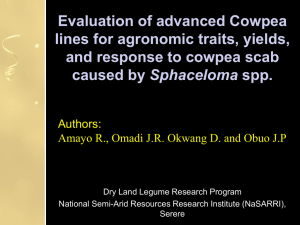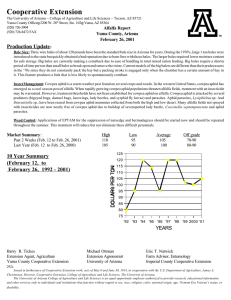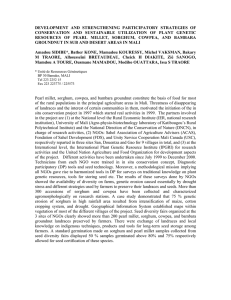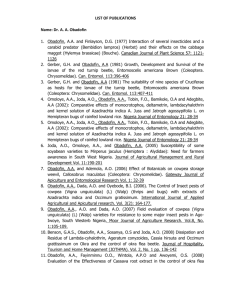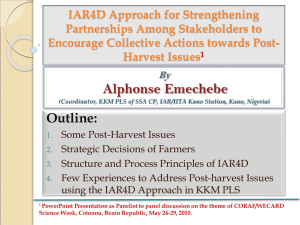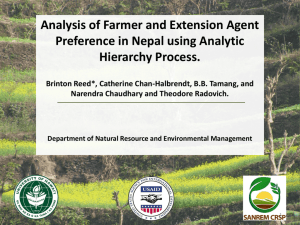Document 14120509
advertisement
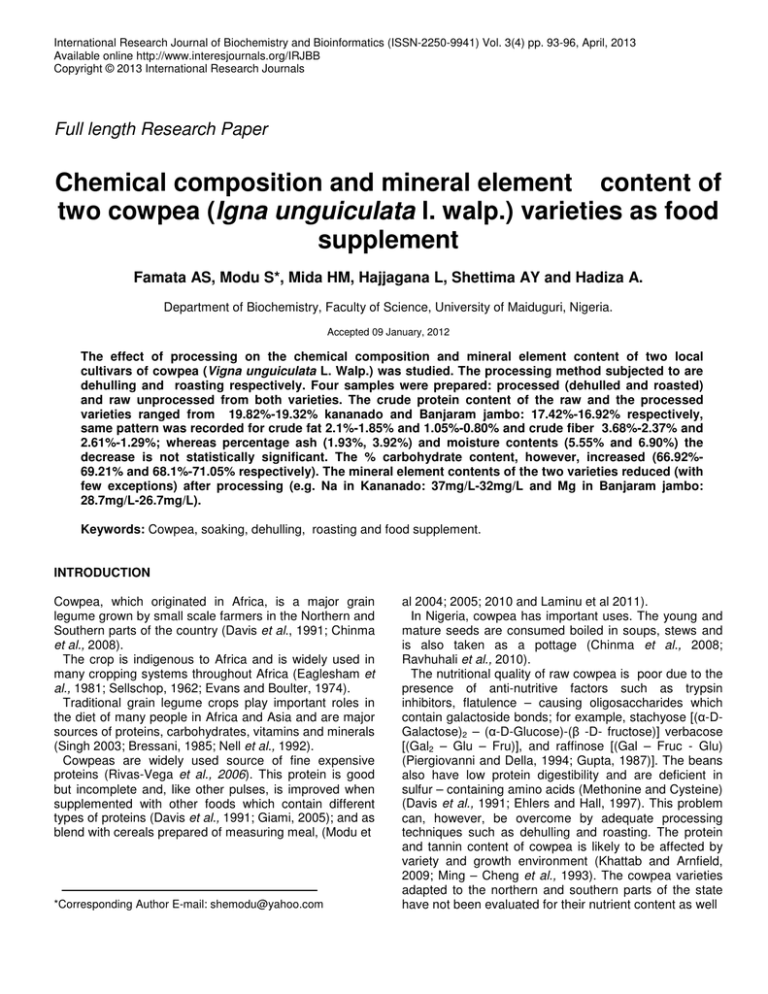
International Research Journal of Biochemistry and Bioinformatics (ISSN-2250-9941) Vol. 3(4) pp. 93-96, April, 2013 Available online http://www.interesjournals.org/IRJBB Copyright © 2013 International Research Journals Full length Research Paper Chemical composition and mineral element content of two cowpea (Igna unguiculata l. walp.) varieties as food supplement Famata AS, Modu S*, Mida HM, Hajjagana L, Shettima AY and Hadiza A. Department of Biochemistry, Faculty of Science, University of Maiduguri, Nigeria. Accepted 09 January, 2012 The effect of processing on the chemical composition and mineral element content of two local cultivars of cowpea (Vigna unguiculata L. Walp.) was studied. The processing method subjected to are dehulling and roasting respectively. Four samples were prepared: processed (dehulled and roasted) and raw unprocessed from both varieties. The crude protein content of the raw and the processed varieties ranged from 19.82%-19.32% kananado and Banjaram jambo: 17.42%-16.92% respectively, same pattern was recorded for crude fat 2.1%-1.85% and 1.05%-0.80% and crude fiber 3.68%-2.37% and 2.61%-1.29%; whereas percentage ash (1.93%, 3.92%) and moisture contents (5.55% and 6.90%) the decrease is not statistically significant. The % carbohydrate content, however, increased (66.92%69.21% and 68.1%-71.05% respectively). The mineral element contents of the two varieties reduced (with few exceptions) after processing (e.g. Na in Kananado: 37mg/L-32mg/L and Mg in Banjaram jambo: 28.7mg/L-26.7mg/L). Keywords: Cowpea, soaking, dehulling, roasting and food supplement. INTRODUCTION Cowpea, which originated in Africa, is a major grain legume grown by small scale farmers in the Northern and Southern parts of the country (Davis et al., 1991; Chinma et al., 2008). The crop is indigenous to Africa and is widely used in many cropping systems throughout Africa (Eaglesham et al., 1981; Sellschop, 1962; Evans and Boulter, 1974). Traditional grain legume crops play important roles in the diet of many people in Africa and Asia and are major sources of proteins, carbohydrates, vitamins and minerals (Singh 2003; Bressani, 1985; Nell et al., 1992). Cowpeas are widely used source of fine expensive proteins (Rivas-Vega et al., 2006). This protein is good but incomplete and, like other pulses, is improved when supplemented with other foods which contain different types of proteins (Davis et al., 1991; Giami, 2005); and as blend with cereals prepared of measuring meal, (Modu et *Corresponding Author E-mail: shemodu@yahoo.com al 2004; 2005; 2010 and Laminu et al 2011). In Nigeria, cowpea has important uses. The young and mature seeds are consumed boiled in soups, stews and is also taken as a pottage (Chinma et al., 2008; Ravhuhali et al., 2010). The nutritional quality of raw cowpea is poor due to the presence of anti-nutritive factors such as trypsin inhibitors, flatulence – causing oligosaccharides which contain galactoside bonds; for example, stachyose [(α-DGalactose)2 – (α-D-Glucose)-(β -D- fructose)] verbacose [(Gal2 – Glu – Fru)], and raffinose [(Gal – Fruc - Glu) (Piergiovanni and Della, 1994; Gupta, 1987)]. The beans also have low protein digestibility and are deficient in sulfur – containing amino acids (Methonine and Cysteine) (Davis et al., 1991; Ehlers and Hall, 1997). This problem can, however, be overcome by adequate processing techniques such as dehulling and roasting. The protein and tannin content of cowpea is likely to be affected by variety and growth environment (Khattab and Arnfield, 2009; Ming – Cheng et al., 1993). The cowpea varieties adapted to the northern and southern parts of the state have not been evaluated for their nutrient content as well 94 Int. Res. J. Biochem. Bioinform. Table 1. Chemical Composition of Raw and Processed Cowpea Cultivar (Kananado) Sample (Cowpea) %Moisture content Raw cowpea;Kan anado 5.55 ± 0.10 Processed cowpea;kan anado 5.50 ± 0.06 %Crude protein a a 19.82 ±0.27 a b 19.32 ± 0.1 %Fat a %Crude fibre a 2.1 ± 0.02 b 1.85 ±0.02 3.68 ± 0.20 b 2.37 ± 0.04 %Ash % Carbohydrate a 1.93 ± 0.14 a 66.92 ± 1.00 a 1.75 ± 0.07 b 69.21 ± 1.80 Values are means of three determinations ± the respective standard deviations. Values on the same column vertically with different superscripts are significantly different (p<0.05). as anti-nutrient status. Hence, this study was conducted to determine the chemical composition; mineral element contents and anti-nutrient status of two local cowpea cultivars. The aim of the work is to determine the effect of processing on the proximate, mineral element and antinutrient status compositions of the local cowpea cultivars. Mineral/Elemental Analysis The mineral element contents of the sample were determined using atomic absorption spectrometry (AAS: model; analyst 400) – as described by Victor (2000). RESULTS MATERIALS AND METHODS The two local cowpea varieties (local Hausa names; Banjaram jambo and Kananado cultivated in both Northern/Southern parts of Borno State, Nigeria) were bought from Monday market, Maiduguri, Borno state. All determinations were made in triplicates and the data obtained were subjected to statistical analysis (students ttest) using the software instat 3 (2000). Chemical Composition (Kananado) Experimental Processing Methods About 1kg of each variety was cleaned (husks and defective seeds removed) and soaked in pure water in a clean ratio of 1:2 in a plastic container. After about 5 minutes, the samples were transferred to a clean mortar and dehuled using a pestle. The pericarps/skins were removed by serious washing in water. The dehuled seeds were dried under sun for about 24 hours. The dry dehuled seeds were then roasted and milled/ground using a clean commercial milling/grinding machine (the initial portions that emerged were discarded to avoid contamination). The dry powders were then sieved and packed in air-tight plastic containers. Chemical Analysis The proximate compositions were determined using AOAC (2004) methods. The Chemical composition of the unprocessed and processed local cowpea cultivar (Kananado) is presented in table above. From the above results, the crude protein, crude fat and crude fibre contents decreased (p<0.05) after processing. However, there was no statistically significant decrease in the moisture and ash contents. The percentage carbohydrate slightly increased after processing. Chemicl Composition (Banjaram Jambo) The Chemical compositions of the unprocessed (raw) and processed Banjaram jambo (local cowpea cultivar) are presented in table 2 below. From table 2 above, the moisture and ash contents of the samples did not statistically reduce (p>0.05) after processing. However, the crude protein, crude fibre, and crude fat decreased (p<0.05) after processing. The % Carbohydrate increased after processing. Famata et al. 95 Table 2. Chemical Composition of Unprocessed and Processed Local Cowpea Cultivars (Banjaram Jambo) Sample %Moisture content %Crude protein a %Fat a Raw cowpea; Banjaram 6.90 ±1.00 Processed cowpea; Banjaram 6.20 ±0.08 a 17.42 ± .20 a %Crude fibre a 1.05 ±0.01 b %Carbohydrate a 2.61 ±0.20 a 3.92 ± 0.13 b 0.8 b ±0.01 16.92 ±0.10 %Ash 68.1 ± 2.01 a 1.29 ± .04 b 3.74 ± 0.06 71.05 ± 2.52 Values are means of three determinations ± the respective standard deviations. Values on the same column vertically with different superscripts are significantly different (p<0.05). Table 3. Mineral Composition of Raw and Processed Local Cowpea Cultivar (Kananado) (mg/L) Sample (Kananado) Raw cowpea; Kananado Processed cowpea; kananado Na K a Mg a 37 ±2.00 a 554 ± 3.00 b 6.88 ± 0.10 Zn a 54.43 ± 0.12 b 550 ± 2.00 P a 10 ± 0.80 a 32 ± 1.00 Ca 45 ± 1.00 a b 54.13 ± 0.20 42 ± 1.00 Fe a 5.72 ±1.00 a 4.71 ± 0.10 a 6.0 ± 0.17 b 5.55 ± 0.05 Values are means of three determinations ± the respective standard deviations. Values on the same column with different superscripts are significantly different (p<0.05). Table 4. Mineral Composition of Raw and Processed Local Cowpea Cultivar (Banjaram Jambo) (mg/L) Sample Code Na a Raw cowpea; Banjaram 50 ±3.0 Processed cowpea; Banjaram 44 ±1.0 b K Mg a a 675 ±3.0 28.7 ±0.8 a b 670 ±2.0 26.7 ±0.2 Ca P a Zn a 68 ±0.24 b 67.4 ±0.10 80.50 ±0.09 b 79.37 ±0.63 a 8.8 ±0.15 b 8.4 ±0.10 Fe a 4.77 ±0.04 b 3.85 ±0.06 Values are means of three determinations ± the respective standard deviations. Values on the same column with different superscripts are significantly different (p<0.05). Mineral Element Content (Kananado) Mineral Element Content (Banajaram Jambo) The results are presented in table 3. The results were statistically analyzed. From the table above, the levels of Na, Mg, P, and Fe, reduced (p<0.05) after processing. However, K, Ca, and Zn did not significantly reduce (p>0.05) after processing. From the above results, it can be seen that the contents of Na, Mg, Ca, P, Zn and Fe decreased (p<0.05) after processing. However, the K level of the raw was not significantly different (p >0.05) from that of the processed sample. 96 Int. Res. J. Biochem. Bioinform. DISCUSSION RECOMMENDATION The proximate compositions of the processed and unprocessed samples are shown in tables 1 and 2. In table 1 (for kananado), the percentage moisture content did not show statistically significant decrease after processing though there was a slight change. The slight decrease in moisture might be due to the roasting process and can increase the shelf life of the processed sample (Giami, 2005). The ash content only showed a slight decrease after processing, however, the crude protein, fat content and crude fibre significantly decreased, after processing and the percentage carbohydrate, on the order hand, significantly increased (p<0.05). These agree with the earlier findings of Rivas – Vega et al (2006). The chemical compositions of Banjaram jambo followed a similar pattern of alterations after processing. The moisture content and ash contents slightly decreased after processing. The decrease in ash might be due to the volatilization of some metal/mineral elements (Bressani, 1985). The decrease in crude protein, percentage fat and crude fibre might be due to the loss of some parts (e.g. the plumules and hulls) of the seeds during the processing method (Rivas – Vega et al. and 2006, Modu et al 2011). This may suggest that the hull part of the seeds contribute to the fibre content. The increase in % carbohydrate shows that the carbohydrate contents (Davis et al., 1991 and Modu et al 2004) were not significantly reduced in the course of processing (Rivas –Vega et al., 2006 and Modu et al 2005). The elemental contents of the processed and unprocessed local cowpea cultivars are presented in tables 3 and 4. For kananado (table 3), there were significant decreases in the levels of Fe, P, Mg and Na. These might account for the slight decrease in the determined ash content ( Rivas-Vega et al., 2006). However, changes in Ca, K and Zn levels were not statistically significant (p <0.05) after processing. These agree with the findings of Chinma et al (2008) and Rivas – Vega et al (2006). With the exception of Na, the contents of all the remaining mineral elements determined statistically decreased (p < 0.05) after processing. This might be due to the fact that most of the mineral elements are located at the pericarp and the “eye” of the seeds (Giami, 2005). It is therefore recommended that processed (dehulled and roasted) cowpea be supplemented with other diets so as to improve its nutritional value. It is also recommended that further studies be carried out on these two local varieties so as to determine other important parameters such as the activity/level of trypsin inhibitor. CONCLUSION From the forgoing it can be deduced that dehulling and roasting alter (mostly reduce) some of the proximate and mineral element contents of cowpea. REFERENCES AOAC (2000). Official Methods of Analysis. Association of Official Analytical Chemists. Washington D.C., 16th Edition. Bressani G (1985). Nutritional value of cowpea. In : Cowpea research, production and utilization. Eds. Singh S.R. & Rachie K.O., John Willey & Sons Ltd. Chinma CE, Alemede IC, Emelife IG (2008). Physicochemical and Functional Properties of Some Nigerian Cowpea Varieties. Pakistan J. of Nutrition. 7 (1): 186 – 190. Davis DW, Oelke EA, Oplinger ES, Doll JD, Hanson CV, and Putnam D.H. (1991). “Cowpea” Alternative Field Crops Manual. 390 (9): 557 – 600. Eaglesham KJ, Avadim AT, Jingel-Chonglu M, Torry Vodker (2001). Analysis of Nutritional Value of Cowpea.Field Crops Risearch. 80:191-197. Ehlers JD, Hall AE (1997). Cowpea (Vigna unguiculata L. Walp).Field Crops Research. 53: 187-204. Evans IM, Boulter D (1974). Chemical methods suitable for screening for protein content and quality in cowpea(Vigna unguiculata) meals. J. of Sci. and Food Agric. 34:311. Giami Y Sunday (2005). Compositional and Nutritional properties of selected newly developed lines of cowpea (Vigna unguiculata L. Walp). J. of Food Composition and Analysis 18: 665 – 673. Gupta YP (1987). Antinutritional and toxic factors in food legumes: a review. Plant Foods for Human Nutrition. 37:201 – 228. Khattab RY, Arnfield SD (2009). Nutritional quality of legume seeds as affected by some physical treatments 2. Antinutritional Factors. LWT – Food Science and Technol. 42:1113 – 1118. Ming – Cheng J, Chang, James W, Bailey, Collins JL (1994). Dietary tannins from cowpeas and tea transiently alter apparent calcium absorption but not absorption and utilization of protein in rats. The J. of Nutrition.39:46-49. Piergiovanni AR, Della Gatta (1994). Alpha-amylase inhibitors in cowpea (Vigna unguiculuta): effects of soaking and cooking methods. Food Chemistry. 51:79 – 81. Ravhuhahi KE, Ng’ambi JW, and Norris D (2010). Chemical composition and enzymatic in vivo digestibility of cowpea cultivars and buffalo grass hay grown in limpopo of South Africa. Livestock Research for Rural Development. 22(9): 2010. Rivas – Vega ME, Goytortia – Bores E, Ezquerra – Braver JM, Salazar – Garga MG, Cruz – Suarez LE, Nolasco H, Civera – Cerecedo R. (2006). Nutritional value of cowpea (Vigna unguiculata L. Walp)meals as ingredients in diets for Pacific white shrimp (Litopenaeus of vannamei Boone). Food Chemistry.97:41 – 49. Sellschop JPF (1962). Cowpeas, Vigna unguiculata (L.) Walp. Review article. Field crop abstracts. 15 :1. Singh B (2003). “Improving the Production and Utilization of cowpea as food and fodder. Field crops research. 84: 169 – 15.



